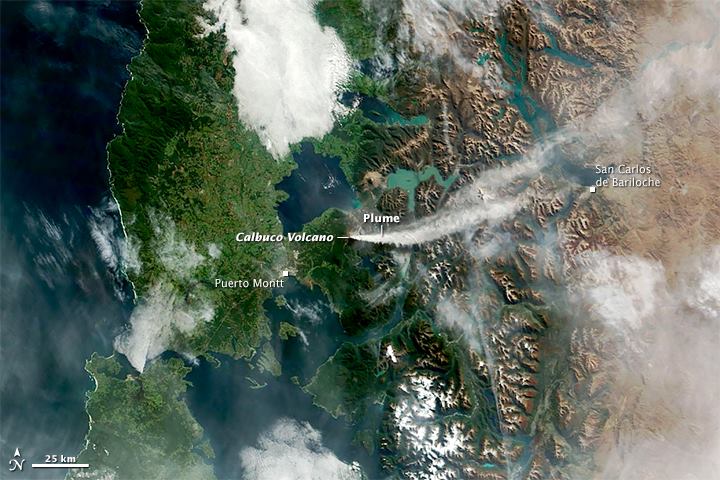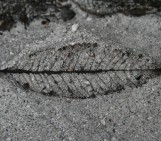
Image of Calbuco volcano on April 24, 2015, from NASA’s Earth Observatory. Natural colour image from the Moderate Resolution Imaging Spectroradiometer (MODIS) on the Terra satellite. The narrow plume of ash and gas is being blown to the East, away from Calbuco and towards the town of San Carlos de Bariloche.
Detailed assessments of what happened during the April 22-23 eruption of Calbuco, Chile, are now coming in from the agencies responsible for the scientific monitoring of the eruption (SERNAGEOMIN) and for the emergency response (ONEMI). The volcano is well monitored and accessible, and as a result there has been a great deal of high quality information, and imagery, made available very quickly. In addition, there is a wealth of satellite remote sensing data, which together allow us to collect up some basic statistics about the scale of the eruption. So here are some summary statistics for now:
- This was the first explosive eruption of Calbuco since a small eruption that lasted 4 hours on 26 August 1972. In the intervening 42 years, there was an episode of strong ‘fumarole’ emission in August 1996, but no recent signs of unrest.
- The eruptions of 22-23 April began with little prior warning, and both formed strong, buoyant plumes of volcanic ash that rose high into the atmosphere – captured in some of the most amazing video and timelapse footage of an eruption anywhere in the world. The first eruption started at 18:05 (local time) on 22 April; the ash column rose to 16 km, and ejected 40 million cubic metres of ash in about 90 minutes. The second eruption began after midnight (01:00 local time, on 23 April), with an ash column that rose to 17 km, and ejected 170 million cubic metres of ash over 6 hours. Based on the volume of material erupted (0.2 cubic km), and the eruption plume height, the combined phases of the eruption can be classified as a VEI 4 event, with an eruption magnitude of 4.4 – 4.6 (depending on the assumed density of the deposits).
- The Calbuco eruption was the third large eruption in this region of Chile in the past 10 years; but 4 or 5 times smaller than the eruptions of Chaiten (2008) and Puyehue Cordon-Caulle (2011).
- At its greatest extent, the ash cloud covered an area of over 400,000 square kilometres, affecting a population of over 4 million people in Chile and Argentina (modelled using CIESIN). Ash fallout was reported from Concepcion, on the Pacific coast, to Trelew and Puerto Madryn on the Atlantic coast of Argentina.
- The magma involved in the eruption was a typical andesite/dacite, containing volcanic glass and crystals of plagioclase and amphibole, with minor quartz and biotite.
- The SO2 gas release from the eruption was substantial – around 0.2 – 0.4 Million tonnes – probably some way short of the levels needed to have a significant impact on the climate system.
- The eruption was accompanied by dramatic pulses of lightning (a common feature in volcanic eruptions), and easily visible from space.
- At least 6500 people were evacuated as a result of the activity. The nearby town of Ensenada was badly affected by thick pumice and ash deposits, and lahars pose continuing hazards in the drainages that run off Calbuco, and into nearby lakes (Llanquihue, Chapo). The eruption has strongly affected some of the salmon fisheries in the region. Downwind, air transportation has been disrupted in Chile, Argentina and Uruguay.
- At the time of writing, SERNAGEOMIN note that the seismic activity has diminished somewhat , but the volcano remains at a red alert.


Esteban Paredes
Correction 2d eruption 01:00 am
davidmpyle
Thanks! Now corrected in the post.
aficientifico
I wrote an article about Calbuco’s eruption and the questions that probably many have. You’re free to comment, criticize, precise, etc to enrich the debate (in spanish)
https://aficientifico.wordpress.com/2015/05/07/volcan-calbuco-las-interrogantes/
aficientifico
The second part with scientific research made after the eruption. Hopefully the docs will be available soon:
https://aficientifico.wordpress.com/2016/01/02/volcan-calbuco-ii-primeros-estudios/
amt07
Reblogged this on FormationVacations.
Pingback: Guest Videos: Osorno and Calbuco Volcanoes | Clear Sight
Pingback: Third Explosive Eruption at Chile’s Calbuco | Nagg
Pingback: Third Explosive Eruption at Chile’s Calbuco | News – Look Magazine
Pingback: Third Explosive Eruption at Chile’s Calbuco | SciMerge
Alex Maureira
Thank you, for such exact summary, I am from Puerto Varas and I’ve being here the whole time . Question, what type of eruption was this ? Strombolian/Vulcanian??